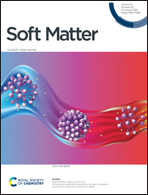Self-healing, self-adhesive, stretchable and flexible conductive hydrogels for high-performance strain sensors†
Abstract
Conductive hydrogels have been widely studied for their potential application as wearable sensors due to their flexibility and biocompatibility. However, the simultaneous incorporation of excellent stretchability, toughness, conductivity, self-healing, and adhesion via a simple method remains a great challenge. Herein, a multifunctional hydrogel with self-adhesion, self-healing, conductivity, and mechanical properties was fabricated by ionic cross-linking of chitosan (CS), the acrylic acid (AA) polymer, and tea polyphenols (TPs) in the presence of graphitized carbon nanotubes (CNTs) in this work. The resultant hydrogel has unique self-healing properties (94.11% for strain self-healing and 90.60% for stress self-healing) and mechanical properties. The fracture stress was 0.075 MPa when the strain was 1184%, and the toughness reached 0.48 MJ m−3. The synergistic effect of free ions and CNTs endows the hydrogel with an excellent electrical conductivity (6.67 S m−1). Moreover, the hydrogel can adhere to various organic and inorganic materials. It exhibits repeatable self-adhesion to human skin and can be peeled off completely without any residual, irritation or allergic reactions. Additionally, the hydrogel also has good strain sensitivity and exhibits stable output signals in motion monitoring of the human body as a biosensor. Therefore, this work provides a new prospect for the design of multifunctional hydrogels for their potential applications in wearable biosensors.



 Please wait while we load your content...
Please wait while we load your content...